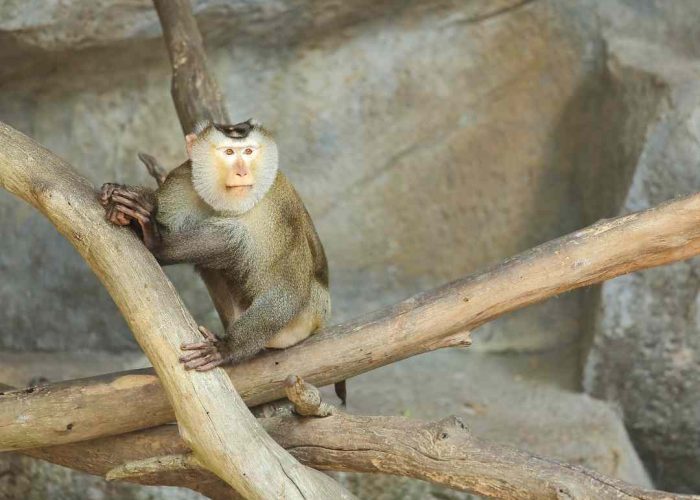The Ministry of Environment released a report highlighting three types of endangered monkeys that are common in Cambodia, including the pig-tailed macaque, pileated gibbon, and stump-tailed macaque.
Macaque pig-tailed
According to Ministry spokesman Neth Pheaktra, the number of rare pig-tailed macaques in the Keo Seima Wildlife Sanctuary in Mondulkiri province has increased to over 2,000 in the last ten years, despite the fact that their global population has decreased.
He stated that the increase in population numbers for the pig-tailed macaque species demonstrates the successful implementation of the Wildlife Sanctuary Protection and Conservation Plan, which is partially funded by the sale of carbon credits in the Keo Seima Wildlife Sanctuary.

There are approximately 1,700 pig-tailed macaques in China, and approximately 1,500 in India. Thailand is also thought to have a sizable population of this species.
"According to a 2020 study conducted by the environment ministry and the Wildlife Conservation Society (WCS Cambodia), the number of pig-tailed macaques within the Keo Seima Wildlife Sanctuary has increased from 733 in 2010 to at least 1,473 in 2020," he said.
Neth Pheaktra
Pheaktra went on to say that the pig-tailed macaque is on the International Union for Conservation of Nature’s (IUCN) Red List of threatened species.
In China, approximately 1,700 pig-tailed macaques are known to exist, while approximately 1,500 are known to exist in India. Thailand is also thought to have a significant population of this species.
Pig-tailed macaques live in dense and mixed forests in families of five to six and in large groups of up to forty.
The species is nomadic and roams through the forest, eating fruits, flowers, grains, and insects foraged from trees and on the ground.

Pileated gibbons
According to the IUCN, there are over 65,000 pileated gibbons worldwide, with Cambodia accounting for more than half of that total.
According to him, Cambodia has the highest population of pileated gibbons in the world, with approximately 35,000 individuals. They are found in Cambodia’s protected areas, particularly in the Cardamom Mountains, where they live in dense and semi-dense forests.
"There are about 30,000 of this species in eastern Thailand, and there are some in southern Laos, but there are relatively few pileated gibbons present there."
Neth Pheaktra
The pileated gibbon is a rare species that is considered globally endangered by the IUCN Red List.
The species is easily distinguished as female or male, with females being white with a head bag and a black chest, and males being black when they are three to four years old, except for white hair on their arms, legs, and around the genitals.
"Pileated gibbons inhabit dense and semi-dense forests." They typically live in small groups of two to five people, which include the mother, father, and children. At the age of six, gibbons become adults. They spend a lot of time in tall trees, jumping from branch to branch in the morning. "It eats a wide variety of fruits, leaves, flowers, and insects."
Neth Pheaktra
Poaching and trapping for the wildlife trade, as well as habitat loss, are threatening the extinction of pileated gibbons. Pheaktra stated that conservation groups and law enforcement officials have worked hard to prevent wildlife trafficking crimes.
According to Pheaktra, the Apsara National Authority, Wildlife Alliance, and Forestry Administration released four pileated gibbon families into the Angkor Archaeological Park’s forests in order to protect and conserve the species.
The environment ministry applauds and appreciates all parties’ collaborative efforts to protect and conserve these rare and endangered pileated gibbons. “I urge everyone to take precautions to protect them, to stop hunting and trapping all wildlife, and to refrain from trading or eating wild meats,” he said.

Stump-tailed macaque
For the stump-tailed macaque, the ministry recorded 56 remaining groups of this globally endangered species in Cambodia in 2020, each of which has between 50 and 60 members.
The species, Macaca arctoides, is listed as vulnerable on the IUCN Red List.
"There is no exact number of stump-tailed macaques in the world." However, research in Cambodia discovered that there are 56 groups of them."
Neth Pheaktra
According to Pheaktra, there are a small number of stump-tailed macaques to the west of the Mekong River and a moderate number to the east of the rivers in Cambodia. They can also be found in northeastern India, southern China, northern Thailand, and parts of Indochina.
The stump-tailed macaque resembles the northern pig-tailed macaque, also known as Macaca leonina. The only difference is that the stump-tailed macaque is larger and has a bright pink or red face than the Macaca leonina. It usually weighs between 8 and 12 kg.
The stump-tailed macaque lives in the rainforest and eats small insects, seeds, fruits, tubers, and other plants.
According to the Wisconsin National Primate Research Centre, they prefer to live in the highlands or in evergreen tropical and subtropical moist broadleaf forests, but they also thrive in colder climates at elevations of up to 4km above sea level.









